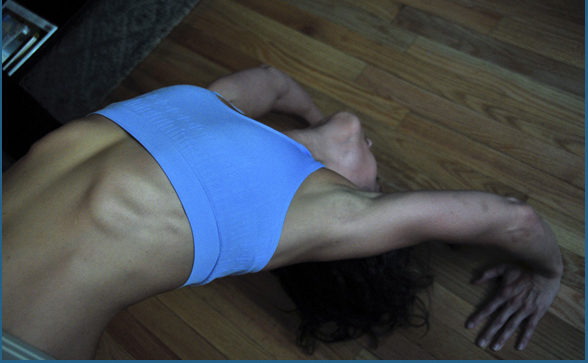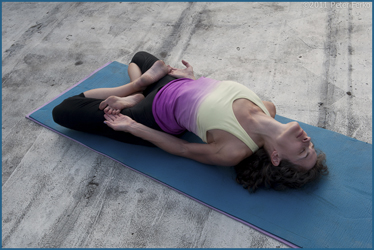stretching the east : on backbends

So, backbends. I’m not good at them. But I need them. I like them. They feel good. They used to feel like a jolt of coffee, because I take so little breath into my upper chest in my regular breathing pattern. To stretch the chest is crazy energizing, especially if you tend to hunch forward. Now that I do them daily, all sorts of things come up.
The more you do yoga, the more subtly you feel your body. The more you feel what it has to say. What you have to say. That is the trickiest thing in writing and talking about yoga. It’s a non-verbal endeavor, truly. Putting words to it can be difficult, and for a thinker, can run into territories of faith. It’s really something you can’t understand unless you have done it, and done it in a way that is accessible for you (i.e. the teacher and style resonate). It’s like meditation. I really can’t take anyone’s theories or analyses of yoga or meditation (eg Zizek) seriously if they haven’t sat on their ass for at least a weekend (that is very very generous. I do not mean you know anything after a weekend, but you now have an idea bigger than theory). Until then, you really have no idea what you’re talking about. It’s just head talk. Disembodied ideas. Blah, blah, blah.
 Right. Backbends. I’ll quote from two books I encountered last time. The first, Yoga: The Spirit and Practice of Moving into Stillness by Erich Schiffmann. I only read the small backbends sections in these books, so I have no recommendation for or against them.
Right. Backbends. I’ll quote from two books I encountered last time. The first, Yoga: The Spirit and Practice of Moving into Stillness by Erich Schiffmann. I only read the small backbends sections in these books, so I have no recommendation for or against them.
Backbends are especially tremendous poses…because they encounter a sense of emotional openness and confidence. They gently open the chest, abdominal organs, pelvic region, and the whole front side of the body—the tender vulnerable side. The chest is where the heart chakra is located. Many of us are closed down and defended in that area, either from a lack of love or from past hurts. The pelvic region is where the sex chakra is located and many of us have contracted and pulled back in that area. We attempt to protect ourselves emotionally by closing down, pulling back, contracting our bodies, and thereby forming a protective shield or barrier. Closing down is not healthy, though. It’s part of what makes you feel more separate psychologically, and it constricts and restricts vital energy flow, which will inevitably cause you to feel more depressed than you would otherwise, more fearful, less vital, and less alive. Not to mention the fact that most of us sit in a somewhat cramped or collapsed position much of the day, anyway—either at a desk, while driving or eating, or in front of the TV–which not only impairs the functioning of the lungs and abdominal organs but causes the spinal vertebrae to push backward out of healthy alignment.
Backbends open these closed areas, thereby releasing blocked energy while simultaneously building the strength needed to stay open. Strong back muscles, developed with backbends, make it easy to sit and stand erect all day long, so you are alert and comfortable more of the time. Backbends give you energy because they release tension and blocked energy in your chest and pelvic regions as well as through the ankles, knees, quadriceps, abdominal organs, upper back, neck, shoulders, and arms. They are rejuvenating. They encourage youthfulness by keeping the spine supple.
(Schiffmann, pp. 199-200)
I appreciate his mention of the pelvis here, which is absent from most discussions of backbending, but hugely involved. The more intense backbends, in fact, slam my major areas of stress. The “sex chakra” analysis is unfortunately simplistic. The root chakra is located in the pelvis as well, and there are all sorts of reasons one might hold in the psoas and pelvic region. When I talked to my Rolfer about my thoracic spine and kyphosis, she went straight to work on my right psoas, where I tend to hold, to release by back. “Whoa. Weird,” I thought.
We need to be careful about reducing matters to the “heart” and “sex” chakras. Though, sure, trouble in the second might well lead to imbalance in the fourth, and vice verse. Though linking sex and the heart almost seems far fetched in the postmodern era. [Tears.]

The other book with some interesting insight was Yoga for Wellness: Healing with the Timeless Teachings of Viniyoga by Gary Kraftsow:
As part of their sunrise practice the ancient yogis called their backward bending “stretching the east.” [They did?] Backward bends stretch and strengthen the front portion of the torso, the shoulder and pelvic girdles, and the legs. They stretch and strengthen the iliopsoas muscles, which lay deep under the anterior musculature of the abdomen and pelvis and bind the legs to the spine; the diaphragm and the intercostals, which are the primary musculature of respiration; the anterior muscles, which bind the shoulder girdle to the spine; and the anterior muscles of the legs. In addition, they strengthen the superficial and deep muscles of the back, which contract as we bend backward; strengthen the posterior muscles of the shoulder girdle; stretch the abdominal organs, relieving the visceral compression; gently compress the kidney/adrenal area, stimulating its function; and stretch the anterior muscles of the neck and throat, including the area of the thyroid and thymus glands.
(Kraftsow, pp. 49-50)
Again, mention of the psoas/pelvis and a nice anatomical view of backbending efforts. It’s weakened by the first line, though, as there’s zero evidence that ancient yogis had a sunrise practice or that they backbended. In fact, only a few backbends (e.g. dhanurasana) are mentioned in the Hatha Yoga Pradapika, which, circa 15 C.E., is hardly ancient. Kraftsow studied with T.K.V. Desikachar, and perhaps that’s where he got his mythology. Yes, the front body is east and back body west. But it’s quite a stretch to bring the ancient yogis daily regimens into the argument, stated as fact. We really have no idea.
I’m rambling a bit here, largely as a process of investigating something. My chest and spine feel locked into place and I’d like them not to be. Talk about the heart chakra, closing down, vulnerability is interesting but not that helpful. I’ve spent time in my body and mind. I know that. Telling someone to open isn’t an open sesame. And even if you are massaged open, if the same mental and behavioral patterns haven’t shifted, the body will go straight back to where it was.
We can all tell sad stories of difficulties and loss. These stories can be liberating or (more usually) just another trap and excuse. The liberation, I gather, comes from experiencing the true emotion behind the tales, rather than a disassociated dramatown plea for attention that wasn’t received when we needed it. But true emotions can be madly elusive, having been avoided and ignored for so many years.
Thus far, the breath has been the most helpful. Luckily, the chest is somewhere I can actually breath into directly. Taking time to really breathe, gently, into the top of my lungs, when I’m practicing, and sitting, and writing.